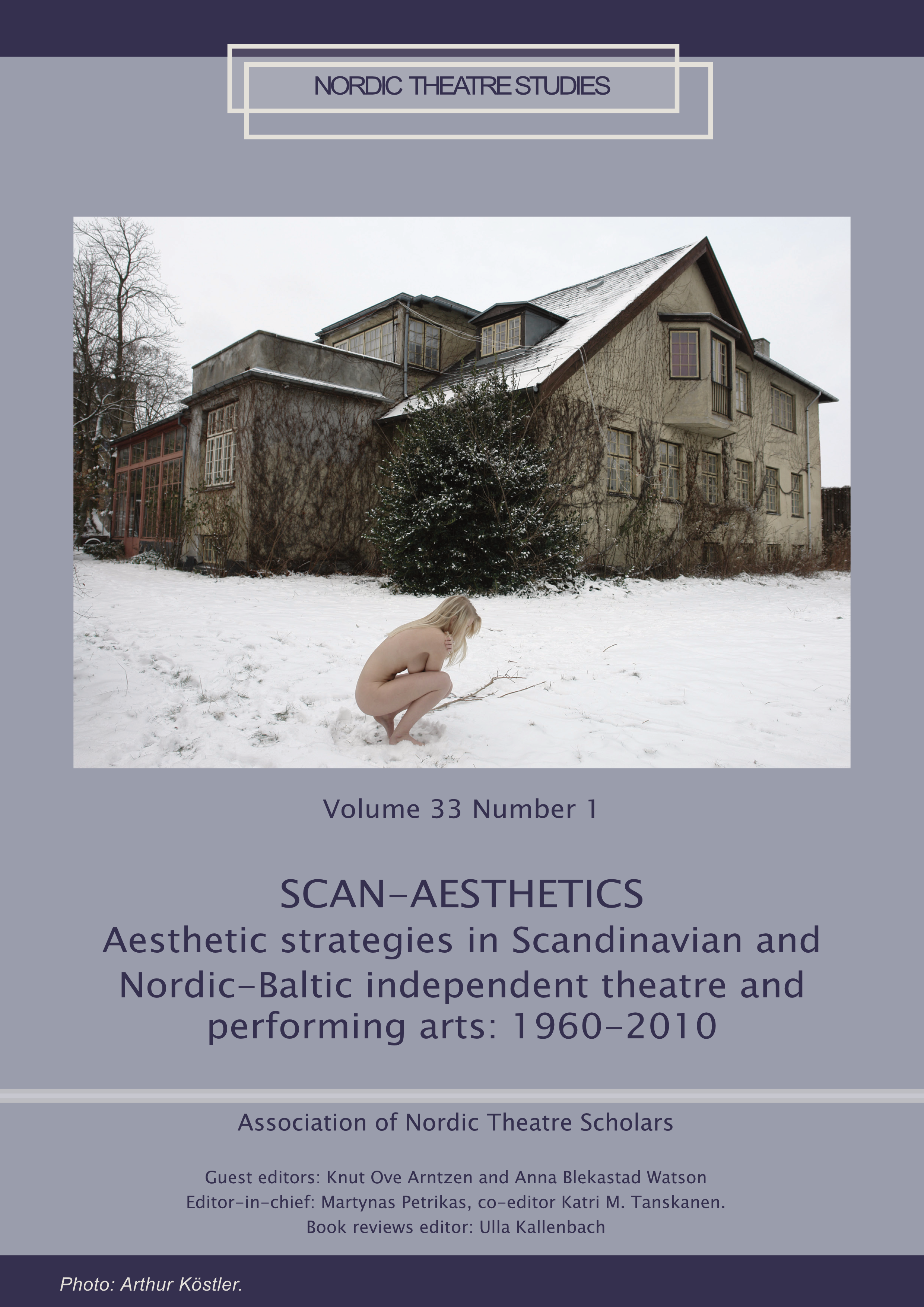The emergence of the independent theatre scene in Estonia (1987–92)
DOI:
https://doi.org/10.7146/nts.v33i1.131993Keywords:
Estonian theatre, independent theatres, theatre system, alternative theatre, postmodern aesthetics, documentary theatre, theatre based on folkloreAbstract
The years 1987–92 mark the first or breakthrough stage of the Estonian transition period from being one of the Soviet republics to a newly independent
democratic state. The cultural processes of the transition are commonly discussed in terms of re-westernization. However, the picture is more complex,
as Western influences intertwined with the legacy of the Soviet cultural realm. The article looks into the interplay between various influences, analyzing the
emerging independent theatre scene from both institutional and aesthetic perspectives. On the institutional level, a range of small groups emerged that
often blurred the line between (semi-)professional and amateur theatre. On the aesthetic level, one can identify three main trends: biographical and/or culturalhistorical documentary theatre; theatre based on the ethnic heritage of different (mostly Northern) nations; postmodern aesthetics. Two more general patterns are 1) the radicalization of Soviet-era artistic searches, empowered by the rise of Estonian nationalism, and 2) the advent of postmodernism, triggered by contemporary Western ideas about theatre.
References
Annus, Epp. 2018. Soviet Postcolonial Studies: A View from the Western Borderlands. London, New York: Routledge.
Avestik, Rait. 2005. Isiklik teater. Tallinn: VAT Teater.
Barnett, Dennis, and Arthur Skelton, eds. 2008. Theatre and Performance in Eastern Europe: The Changing Scene. Lanham: Scarecrow Press.
Epner, Luule, and Anneli Saro. 2020. “Constructing Finno-Ugric Identity through theatre.” Nordic Theatre Studies 32:2, 156–73.
Garancis, Kristiina. 1997. “Peeter Jalakas otsib Püha Graali.” Sirp, 12.09, 7.
Karusoo, Merle. 2014. “Intervjuu Merle Karusooga.” Methis 14, 136–143. DOI: 10.7592/methis.v11i14.3699.
Kruuspere, Piret. 2010. “Omaeluloolisus eesti teatris: Merle Karusoo lavastustest.” Methis 5-6, 131–42. DOI: https://doi.org/10.7592/methis.v4i5-6.524
Kuutma, Kristin. 2005. “Vernacular religions and the invention of identities behind the Finno- Ugric Wall.” Temenos : Nordic Journal of Comparative Religion, 41:1, 51−76.
Lauristin, Marju. 1997. “Contexts of Transition.” In Marju Lauristin, Peeter Vihalemm, Karl Erik Rosengren, Lennart Weibull (eds.), Return to the Western World: Cultural and Political Perspectives on the Estonian Post-Communist Transition. Tartu: Tartu UP, 25–40.
Lauristin, Marju, and Peeter Vihalemm. 1997. “Recent Historical Developments in Estonia: Three Stages of Transition (1987-1997).” In Marju Lauristin, Peeter Vihalemm, Karl Erik Rosengren, Lennart Weibull (eds.), Return to the Western World: Cultural and Political Perspectives on the Estonian Post-Communist Transition. Tartu: Tartu UP, 73–126.
Monaco, Pamela, and Leena Kurvet-Käosaar. 2002. “Investiganting Wor(l)ds: The Personal Is Political in the Drama of Merle Karusoo and Anna Deavere Smith.” Interlitteraria 7: II, 290–304.
Rähesoo, Jaak. 1990. “Baltoscandal ʼ90.” Reede 13.07, 7.
Rähesoo, Jaak. 2008. Estonian Theatre. 3rd ed. Tallinn: Estonian Theatre Union.
Rähesoo, Jaak. 2011. Eesti teater. Ülevaateteos. 1. Tallinn: Eesti Teatriliit.
Rähesoo, Jaak. 2020. “The Center and the Fringe: Post-Soviet Alternative Theatre in Estonia.” In Vessela S. Warner, Diana Manole (eds.), Staging Postcommunism: Alternative Theatre in Eastern and Central Europe after 1989. Iowa: University of Iowa Press, 17–31.
“Roheline tee veidrustele.”1991. Teater. Muusika. Kino 4, 50–54.
Ruus, Katrin. 2005. “Von Krahli Teatri arengulugu.” BA thesis in theatre research. University of Tartu.
Saro, Anneli. 2009. “The Dynamics of Estonian Theatre System: in Defence of Repertoire Theatre.” Methis 3, 93–107.
Saro, Anneli. 2010. “Eesti teatrisüsteemi dünaamika.” In Saro, Anneli and Luule Epner (eds.). Interaktsioonid: Eesti teater ja ühiskond aastail 1985–2010. Tartu: TÜ kultuuriteaduste ja kunstide instituut, 8–36.
“Stuudioteatrid: lähetus ellu”. 1987. Sirp ja Vasar 6.03., 6.
Tomps, Katarina. 2018. “Festival kui teatrisündmus – Baltoscandal 1990–2016.” MA thesis in theatre research. University of Tartu.
Tonts, Anu. 1998. “Luuleteater Valhalla.” BA thesis in theatre research. University of Tartu.
Türnpu, Anne. 2000. “Pärimusest lavastuseni.” MA thesis in theatrical art. Estonian Academy of Music and Theatre.
Visnap, Margot. 1988. “„Valhalla” – sõpruskond või teater?” Teater. Muusika. Kino 10, 42–52.
Visnap, Margot. 1990. “Teatritargutusi.” Teater. Muusika. Kino 2, 76–77.
Warner, Vessela, and Diana Manole (eds.). 2020. Staging Postcommunism: Alternative Theatre in Eastern and Central Europe after 1989. Iowa: University of Iowa Press
Warner, Vessela S. 2020. “Alternative Theatre in the Postcolonies of Communism.” In Vessela S. Warner, Diana Manole (eds.), Staging Postcommunism: Alternative Theatre in Eastern and Central Europe after 1989. Iowa: University of Iowa Press, xvii–xxv.
Yurchak, Alezei. 2006. Everything Was Forever, Until It Was No More: The Last Soviet Generation. Princeton, Oxford: Princeton UP.
This work was supported by the Estonian Research Council, grant PRG636.
Downloads
Published
How to Cite
Issue
Section
License
The copyright belongs to the authors and Nordic Theatre Studies. Users can use, reuse and build upon the material published in the journal but only for non-commercial purposes. Users are allowed to link to the files, download the files, distribute the files on a local network (preferably by links), upload the files to local repositories if their institutions require them to do so, but not republish the files without proper agreements with the journal and the author.

